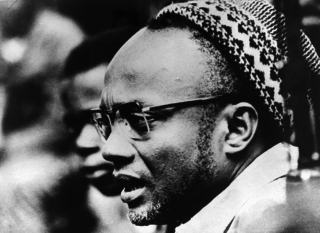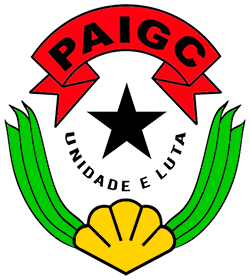Liberation Front of Portuguese Guinea and Cape Verde | |
|---|---|
| Leader | Amilcar Cabral |
| Founded | 1960 |
| Dissolved | Unknown |
| Headquarters | Dakar |
| Ideology | Communism Marxism-Leninism African nationalism African socialism Anti-imperialism Left-wing nationalism |
| Political position | Left-wing |
The Liberation Front of Portuguese Guinea and Cape Verde (Portuguese: Frente de Libertação da Guiné Portuguesa e Cabo Verde, FLGC) was a militant political party in Guinea-Bissau, then part of Portuguese Guinea, formed to seek independence from Portugal. [1]

Guinea-Bissau, officially the Republic of Guinea-Bissau, is a country in West Africa that covers 36,125 square kilometres (13,948 sq mi) with an estimated population of 1,815,698.

Portuguese Guinea, called the Overseas Province of Guinea from 1951, was a West African colony of Portugal from the late 15th century until 10 September 1974, when it gained independence as Guinea-Bissau.
It was established in Dakar in 1960 by Amilcar Cabral and Henri Labėry from an amalgamation of the Liberation Movement of Portuguese Guinea and the Cape Verde Islands (French:Mouvement de Liberation de la Guinee Portugaise et des Iles du Cap Vert, MLGCV) with other groups such as the Liberation Movement of Portuguese Guinea (Portuguese: Movimento de Libertação da Guiné Portuguesa, MLGP)

Dakar is the capital and largest city of Senegal. It is located on the Cap-Vert peninsula on the Atlantic coast and is the westernmost city on the African mainland. The city of Dakar proper has a population of 1,030,594, whereas the population of the Dakar metropolitan area is estimated at 2.45 million.
Its life was short due to internal conflict and it was soon replaced by the United Liberation Front (Front Uni de Libération, FUL), a predecessor of the Struggle Front for the National Independence of Guinea (Frente de Luta Pela Independencia Nacional da Guine-Bissau, FLING)

The Struggle Front for the National Independence of Guinea was a political movement in Guinea-Bissau. Founded by groups opposed to the Marxist doctrine of Amílcar Cabral and the African Party for the Independence of Guinea and Cape Verde (PAIGC), FLING played a minor role in the national liberation struggle against Portuguese colonial rule.





